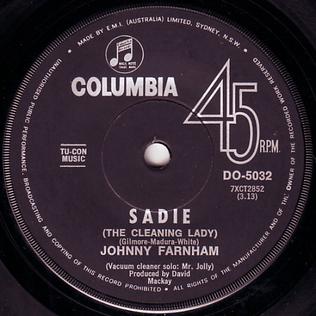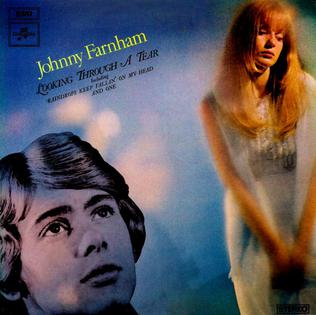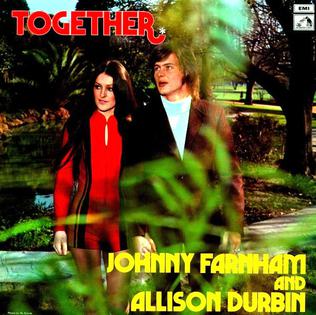
Johnny Young is a Dutch Australian singer, composer, record producer, disc jockey, television producer and host. Originally from Rotterdam, The Netherlands, his family settled in Perth in the early 1950s. Young was a 1960s pop singer and had a number-one hit with the double-A-sided single, "Step Back" and a cover of the Strangeloves' "Cara-lyn" in 1966. Young's profile was enhanced by a concurrent stint as host of TV pop music program The Go!! Show. Also in the mid-1960s, Young toured with the Rolling Stones and supported Roy Orbison.
Jamie Redfern is an English-born Australian television presenter and personality and pop singer. Redfern was an original cast member of children's variety show, Young Talent Time from April 1971 to early 1972, before leaving the show to tour in the US with Liberace. According to Australian musicologist, Ian McFarlane, he "possessed a booming, mature voice which belied his tender age... [he] scored four Top 40 hit singles and sold more than $1.3 million worth of records." His equal highest-charting singles were the double-A sided covers of "Rainbow on the River"/"We'll Meet Again", and "Venus", which each peaked at No. 8 on the Go-Set national charts.
Go-Set was the first Australian pop music newspaper, published weekly from 2 February 1966 to 24 August 1974, and was founded in Melbourne by Phillip Frazer, Peter Raphael and Tony Schauble. Widely described as a pop music "bible", it became an influential publication, introduced the first national pop record charts and featured many notable contributors including fashion designer Prue Acton, journalist Lily Brett, rock writer / band manager Vince Lovegrove, music commentator Ian "Molly" Meldrum, rock writer / music historian Ed Nimmervoll and radio DJ Stan Rofe. It spawned the original Australian edition of Rolling Stone magazine in late 1972.
Colleen Hewett is an Australian singer and actress.
Ronald Leslie BurnsAM is an Australian retired rock singer-songwriter and musician.
Edward Charles Nimmervoll was an Australian music journalist, author and historian. He worked on rock and pop magazines Go-Set (1966–1974) and Juke Magazine (1975–92) both as a journalist and as an editor. From 2000, Nimmervoll was editor of HowlSpace, a website detailing Australian rock/pop music history, providing artist profiles, news and video interviews. He was an author of books on the same subject and co-authored books with musicians including Brian Cadd and Renée Geyer.

"Sadie (The Cleaning Lady)" was Australian pop singer Johnny Farnham's first solo single. The novelty song was released in November 1967 and was No. 1 on the Go-Set National Singles Charts for five weeks in early 1968 (six weeks on the Australian charts in 1968 based on the Kent Music Report). It was the largest-selling single in Australia by an Australian artist in the 1960s. "Sadie" sold approximately 183,000 copies in Australia and was the highest-selling Australian single until "Up There Cazaly" was released in 1979. It was also released in New Zealand, Denmark and Germany. The B-side, "In My Room", was written by Farnham. The A-side's label includes the acknowledgement "Vacuum cleaner solo: Mr. Jolly".
Lynne Randell was an English Australian pop singer. For three years in the mid-1960s, she was Australia's most popular female performer and had hits with "Heart" and "Goin' Out of My Head" in 1966, and "Ciao Baby" in 1967. In 1967, Randell toured the United States with The Monkees and performed on-stage with support act Jimi Hendrix. She wrote for teen magazine, Go-Set, and television programme guide, TV Week. While on the US tour, Randell became addicted to methamphetamine, an addiction which she battled for most of her life.
The Groop were an Australian folk, R&B and rock band formed in 1964 in Melbourne, Victoria and had their greatest chart success with their second line-up of Max Ross on bass, Richard Wright on drums and vocals, Don Mudie on lead guitar, Brian Cadd on keyboards and vocals, and Ronnie Charles on vocals. The Wesley Trio formed early in 1964 with Ross, Wright and Peter McKeddie on vocals; they were renamed The Groop at the end of the year.
The Australian 1970 Radio Ban or 1970 Record Ban was a "pay for play" dispute in the local music industry that lasted from May until October. During this period, a simmering disagreement between commercial radio stations – represented by the Federation of Australian Radio Broadcasters (FARB) – and the six largest record labels – represented by Australasian Performing Right Association (APRA) – resulted in major United Kingdom and Australian pop songs being refused airplay. The government-owned Australian Broadcasting Corporation – which had its own copyright and royalty arrangement with recording and music publishing companies – did not take part in the dispute. The ban did not extend to releases by American artists. Some radio disc jockeys, such as Stan Rofe, defied the ban by playing songs according to their personal tastes.
Somebody's Image was a short lived rock and pop Australian band, most famous for the Joe South's cover "Hush" which peaked at number 15 in Australia in 1967.
Australian pop music awards are a series of inter-related national awards that gave recognition to popular musical artists and have included the Go-Set pop poll (1966–1972); TV Week King of Pop Awards (1967–1978); TV Week and Countdown Music Awards (1979–1980); the Countdown Awards (1981–1982) and Countdown Music and Video Awards (1983–1987).
The Groove was an Australian R&B, pop group which formed in early 1967 with the lineup of Geoff Bridgford on drums, Jamie Byrne on bass guitar, Tweed Harris on keyboards, Rod Stone on guitar and Peter Williams on lead vocals and guitar. In December 1967 their single, "Simon Says", peaked at No. 17 on the Go-Set National Top 40 Singles Chart. They followed with "Soothe Me", which peaked at No. 14 in April 1968. Also in April they released their self-titled debut album. In July that year they won the national final of the Hoadley's Battle of the Sounds competition with the prize including a trip to London. They relocated there in March 1969, and early the following year they changed their name to Eureka Stockade, they disbanded in 1971. On 13 October 2004 Tweed Harris died of throat cancer, aged 63.
Phillip Frazer is a writer, editor and publisher. He was a founder of the weekly teen pop newspaper Go-Set in 1966, which was a popular Australian music paper from 1966 to 1974. He also published the more explicitly counterculture magazines Revolution, High Times and The Digger. He launched the Australian edition of Rolling Stone magazine, first as a supplement in Revolution in 1970, then as a full-fledged magazine in 1972. From 1976 to 2011, Frazer lived in the United States, where he launched and edited numerous political publications, most notably The Hightower Lowdown and Multinational Monitor.
Gregory John Macainsh is an Australian former musician and songwriter. He provided bass guitar and backing vocals for pop rockers, Skyhooks from 1973 to 1980 and subsequently for various reformations. According to Australian musicologist, Ian McFarlane, "Macainsh's biting, provocative songs were the perfect expression of adolescent obsessions and frustrations. With those songs, the band made an enormous impact on Australian social life." Macainsh became an intellectual property lawyer.

Sadie is the debut studio album by Australian pop singer John Farnham it was released by EMI Records in April 1968. The lead single, "Sadie " had been released in November 1967, it was No. 1 on the Go-Set National Singles Charts for five weeks, and was the largest selling single in Australia by an Australian artist in the 1960s. The single, "Sadie " sold approximately 180,000 copies in Australia, and was also released in New Zealand, Denmark and Germany. The second follow up album single was Jeff Barry/Ellie Greenwichs "Friday Kind of Monday" included on the album and was released in March as a double-A side with a cover of Flanagan and Allens, "Underneath the Arches" as Farnham's second single, which peaked at No. 6.

Looking Through A Tear is the third studio album by Australian pop singer Johnny Farnham, the title of which relates to a song on the album, which is a cover of an Aretha Franklin number. it was released in Australia by EMI Records in July 1970. Farnham's covers of Harry Nilsson's penned "One" which became a hit for Three Dog Night and a cover B. J. Thomas' single "Raindrops Keep Fallin' on My Head" were released as singles, and helped to propel the album to No. 11 on the Australian Kent Music Report Album Charts. "One"/"Mr. Whippy" was released as a double A-side in July 1969 and peaked at No. 4 on the Go-Set National Singles Charts. "Raindrops Keep Fallin' On My Head" was released in November and peaked at No. 1 for seven weeks in January–March 1970. Farnham wrote two songs for the album.
James Keays was a Scottish-born Australian musician who fronted the rock band The Masters Apprentices as singer-songwriter, guitarist and harmonica-player from 1965 to 1972 and subsequently had a solo career. He also wrote for a music newspaper, Go-Set, as its Adelaide correspondent in 1970 and its London correspondent in 1973.

Ian Alexander "Molly" Meldrum AM is an Australian music critic, journalist, record producer and musical entrepreneur. He was the talent coordinator, on-air interviewer, and music news presenter on the former popular music program Countdown (1974–87) and is widely recognised for his trademark Stetson hat, which he has regularly worn in public since the 1980s.

Together is a studio album of duets by Australian pop singers John Farnham and Allison Durbin, which was released on HMV for EMI Records in September 1971. It peaked at No. 20 on the Australian Go-Set's Albums Chart.





